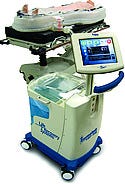System Helps Cardiac Arrest Patients Chill Out
May 6, 2009
Originally Published MPMN May 2009
ENGINEERING SOLUTIONS: MDEA
System Helps Cardiac Arrest Patients Chill Out
|
The ThermoSuit body-cooling system is designed to rapidly cool a cardiac arrest patient's core temperature in order to prevent neurological damage. |
Beginning this year, New York City joins a growing number of cities that require ambulances to take cardiac arrest patients only to those hospitals equipped to induce therapeutic hypothermia. Endorsed by the American Heart Association and gaining popularity, therapeutic hypothermia is the rapid cooling of the body to minimize potential neurological damage caused by oxygen deprivation of a cardiac arrest patient’s brain.
But despite demonstrated efficacy, the cooling process has been somewhat slow to catch on owing to precise temperature regulation requirements and a lack of sophisticated equipment. Life Recovery Systems HD LLC (LRS; Waldwick, NJ; www.life-recovery.com) is looking to change that with the ThermoSuit body-cooling system, one of this year’s MDEA-winning products. The ThermoSuit system is designed to rapidly cool a patient’s core temperature to 33°C in 20 minutes or less.
“To our knowledge, it’s the only [product] that cools with thin-film liquid convection,” says Robert Schock, LRS vice president of R&D. “We pump cold liquid—in this case cold water—over the body in a thin layer and move it to extract heat from the skin. This is a really effective way to extract heat from the body compared with conventional cooling blankets and ice cubes.” Conventional methods typically feature a layer of material that separates the skin from direct contact with the coolant, thereby creating thermal resistance, according to Schock. “Direct moving liquid seems to extract heat at least six times [faster than] if you have one of these plastic boundary layers,” he adds.
Ensuring direct skin-to-water contact in the ThermoSuit is a body enclosure, manufactured by thermoplastic medical device specialist Dielectrics (Chicopee, MA; www.dielectrics.com). The inflatable, porous-batting-lined tub is designed with a self-adjusting sling system that adapts to a patient’s shape and size for optimal cooling. Dielectrics also created a plastic sheet that sprays ice water on the front of the patient for even distribution of coolant over the entire body. “That involved [radio-frequency] welding a network of channels with perforations in them making up the top cover, which is draped over the top of the suit, and selecting a material that would actually drape and contour over the body’s surfaces,” explains Adam Epstein, Dielectric’s vice president of R&D. The company elected to use thermoplastic urethane for its biocompatibile and stretchable nature, as well as for its stability amid extreme temperature changes.
For assistance with the industrial design of the control unit and disposable interfaces, LRS turned to Ximedica (Providence, RI; www.ximedica.com), a full-service medical device design and engineering firm. Among its contributions to the ThermoSuit is a complex hose that connects the suit enclosure with the control unit. Although simple to use, the connecting hose features five lines: two water inlets, two air inlets, and a water outlet to regulate the air and water in the suit. In addition, the company developed a gear drive system designed to actually pump water out of the suit in a worst-case scenario from roughly 20 in. away—an action for which many pumping methods are not suitable, according to David Robson, Ximedica’s vice president of development.
Recruited for engineering the system responsible for pumping the water into the suit, Nexcore Technologies Inc. (Waldwick, NJ; www.nexcoretech.com) lent its expertise to a number of mechanical and electrical engineering tasks, as well as software development. “They had expertise in designing new pumping systems with monitoring functions and valving systems, which were needed to inflate the suit with air and regulate the different air pressures,” recalls Schock. Configured to operate at the optimal flow rate of 14 L/min for rapid cooling, the pump system manufactured by Nexcore consists of two water pumps, an air pump, regulating valves, and a computer controller.
“The other challenge was to make it almost foolproof for the end-user, so the software guides the user through each step of the procedure,” adds Milton Frank, Nexcore president.
In addition to simplicity, Nexcore focused on engineering the software for safety. For example, the software safeguards a patient from being overcooled. Although physicians have the option to end the procedure at any time, the unit signals when the patient’s core body temperature, taken by an esophageal temperature probe, approaches the preset target temperature. “If they don’t take care of that within a minute, the system will automatically purge the water out of the suit and into the reservoir,” Frank says.
In response to extensive user research, the team designed the system to keep working even after the cooling process is complete. “Through discussions with doctors, even though the device automatically regulates treatment based on the patient’s core temperature, it was clear that they wanted to be able to see a graphical representation of body temperature on the screen over time,” Robson notes. “This provided them with an extra measure of confidence that the desired clinical effect was being accomplished.”
Confidence is something that the development team behind the ThermoSuit has in its MDEA-winning device. “Up until this device, there was never a practical way to do this in an ER setting without making a mess,” Robson says. “This has been the first really practical, really fast way to address this kind of emergency situation.”
Copyright ©2009 Medical Product Manufacturing News
You May Also Like


.png?width=300&auto=webp&quality=80&disable=upscale)
